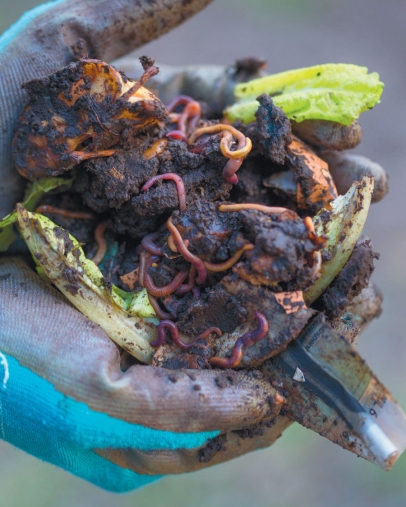Gardening with Wigglers
Worms Produce the Caviar of Compost
Joyce Starr got into vermicomposting by happenstance. Already a master gardener, she was training four years ago to become a master composter when she attended a vermicomposting workshop.
Raising earthworms in a controlled environment is called vermiculture. Using those earthworms alongside microorganisms to convert organic waste into nutrient-rich humus is called vermicomposting. Humus is the part of soil that contributes to the retention of moisture and nutrients.
“I didn’t really know that people did it, but I left that night with a bucket of worms,” Joyce says of vermicomposting.
At her home in Springdale, she kept those first red wigglers in damp bedding inside five-gallon buckets. Two buckets were stacked together, with holes drilled in the bottom of the top bucket for drainage. She recommends this size and style of set up for anyone getting starting in vermicomposting.
At first, she thought she’d need to check the worms every day, and that she’d just taken on a big time commitment. It turns out that it was fine for her to check them once every week or even every two weeks.
“It’s not labor intensive, and it doesn’t take a lot of your time,” she says. “You will find a rhythm for that.”
The castings produced by worms are of a higher quality than typical compost, and have been called the “caviar of compost.” Regular compost is made by mixing organic matter such as leaves, garden residue, and food waste, and then letting that break down over several weeks or months into humus.
Joyce doesn’t have many trees around her house, so there aren’t enough fallen leaves for her to make regular compost. Vermicompost works better for her, and “now I have something to do with my table scraps,” she says.
There are various methods for harvesting the worm castings. Joyce goes a step further and makes vermicompost “tea,” a technique that involves putting the castings in a knee-high stocking and using aeration equipment in a five-gallon bucket over two days. This method produces fertilizer that contains more nutrients and microbes than are found in the castings alone.
She uses vermicompost in her garden, particularly on her tomato plants, because she prefers not to use chemical fertilizers. She says the resulting plants are healthier and greener.
Joyce says vermicomposting has two main benefits. First, organic food waste isn’t going down the garbage disposal or into the garbage can, and then onto the sewage treatment plant or the landfill. Second, compost can be made rather than purchased. A bonus is that vermicompost is odor free, unlike traditional compost.
The first step required in determining how many worms are needed is to assess the average amount of food scraps and other waste to be buried in the worm bin each day. A household that generates seven pounds of food waste a week would average one pound of waste per day.
Worms can be purchased by the pound, and a ratio of two pounds of worms for every one pound of food waste is recommended. A worm bin should be about one square foot of surface for each pound of food waste produced per feeding.
Though Joyce began with five-gallon buckets, she has expanded to 28-gallon plastic storage containers – solid colors that don’t let in light. Her worm population kept multiplying, and she wanted to produce more vermicompost.
Red wigglers can be ordered from many online sources, and they also are available for participants of the composting and vermicomposting class offered at Washington County Extension Office in Fayetteville. See information on page 38 for the next class, scheduled for April 24.
Red wigglers are tough and can withstand the handling required for vermicomposting. They thrive in temperatures ranging from 59° to 77°; they eat more and reproduce more in these temperatures. They slow down and could die above 86° and are subject to freezing below 32°. The temperature in moist bedding is generally lower than the surrounding air because evaporation of the moisture from the bedding in a well-ventilated area has a cooling effect.
It’s important to keep their bedding moist, but not too moist. Worms breathe through their skin, which must be moist for the exchange of air and excretion to take place. However, too much water can reduce the available oxygen, effectively causing them to drown.
Worms can tolerate a wide range of acidity, but slightly acidic conditions, ranging from pH5 to pH9, are best for them. They also use oxygen and produce carbon dioxide, so it’s important to allow air to circulate around the container in which they’re kept.
Some worm bins can be assembled or built at home, while others are available commercially. No matter what their shape or size, the bins should be 12 to 18 inches deep and must have holes in the sides, top, and bottom to allow for adequate air circulation and water drainage.
Where to place the worms is a personal choice. Joyce keeps hers outside on a covered porch most of the year, moving them into the garage during cold weather. Some people keep them inside the house – even in the kitchen. “A basement would be perfect,” she says.
Worms can be fed a variety of foods on a regular basis; a detailed list of what they can and cannot eat is on page 37. Part of their regular diet includes apples, grapes, bananas, tomatoes, bell peppers, and squash. Items that can be fed to the worms, though less often, include oatmeal, tea bags, newspapers, eggshells, and bread. Foods and other items that should never be fed to worms include meat, pickled foods, anything in the cabbage family, salt, dairy, garlic, and grass.
“If you put a banana peel in there or avocado – their favorite foods – there will be like 300 worms on it,” Joyce says.
It takes the worms about four to six months to start producing vermicompost. Joyce warns against overfeeding the worms. If there’s too much food waste, the food itself will start composting before the worms can get to it, which will produce odors. Also, if the soil is too wet, the worms will start trying to climb the sides of the container to escape.
Though she doesn’t particularly like handling the worms themselves, Joyce says the process of watching them produce vermicompost is fun and interesting. And she loves the idea that the worms she has now are descendants of that first batch she brought home from class four years ago.
Attend a class
The next composting and vermicomposting class offered at Washington County Extension Office is scheduled for April 24. The class is free, but interested parties should register by phone or email prior to the event.
Washington County Extension Office
2536 N. McConnell Ave., Fayetteville, AR 72704
479-444-1755
Fun Facts ABOUT Red Wigglers
They have no eyes, teeth, or sense of smell.
They can eat about half their body weight in food each day.
A mature worm can produce 96 baby worms in six months. It takes a worm five to six weeks to reach maturity.
They are photosensitive and only work in the dark.
They have gizzards that need grit to help grind up their food.
They are hermaphroditic (they have both male and female sex organs), but two worms are needed to reproduce.
The two worms join together and exchange sperm, and both worms secrete cocoons that contain eggs.
They can tolerate a range of temperatures, acidity, and moisture conditions.
Though Red Wigglers are a species of earthworm, they are rarely found in soil.
MAKE YOUR OWN WORM FARM
1- Acquire a bin.
Two 5-gallon buckets nestled inside one another work well. The top bucket should have a lid. Drill holes in the top and along the sides of the top inch of the bucket so the worms can breathe, as well as in the bottom of the top bucket so it can drain.
2- Prepare the bedding.
Instead of soil, composting red worms live in moist newspaper bedding. Tear newsprint into 1/2-inch to 1-inch strips. Wet and wring newsprint until bedding feels like a damp sponge – moist but not dripping.
Add the strips to the bin, making sure bedding is fluffy (not packed down) to provide air for the worms. Bin should be 3/4 full of wet newspaper strips.
Sprinkle soil in bin, which introduces beneficial microorganisms. Gritty soil particles also aids the worms’ digestive process.
3- Add the worms.
Worms are typically purchased by the pound. Place them near the center of the bin, halfway down in the bedding.
4- Bury food scraps under bedding.
Feed the worms fruit and vegetable scraps at a ratio of one pound of food waste for every two pounds of worms. See the table at right for a recommended menu.
Cut or break food scraps into small pieces – the smaller, the better. Bury food scraps in the bin, about halfway down in the bedding, near where worms were placed. Cover food with bedding.
5- Leave them be.
Cover the bin with a lid, and place the bin away from windows and heaters. Ideal temperature range is 59 to 77°.
6- Feed, water, and fluff.
To keep worms happy, feed them about once a week. If bedding dries up, spray with water. (If bedding gets too wet, add dry newspaper strips.) Fluff up bedding every week or so to ensure the worms get enough air.
Monitor the bin every week or so to see if the worms are or are not eating the food. Adjust feeding levels accordingly.
Compost Happens
Up for an educational chuckle? Check out the Washington County Master Composters’ music video on how compost is made.
Search YouTube for “Compost Happens by Washington County, AR, Master Gardeners” or check out the link on our website: EdibleOzarkansas.com/CompostHappens
What’s on the Menu?
Foods that worms can be fed on a regular basis*:
apples
avocados
bananas
banana
peels
bell
peppers
berries
cantaloupe
carrots
corn
grapes
lettuce
mangoes
peaches
pears
squash
tomatoes
watermelon
zucchini
Foods that are easily eaten by worms but should not be fed to them on a regular basis:
bread
coffee
grounds
cornmeal
eggshells
leaves
oatmeal
paper towels
tea bags
Do not feed worms these items:
dairy
cabbage (or any foods from the cabbage family)
citrus fruits
cornmeal mix (contains salt and other ingredients)
salt (can cause dehydration)
grass
yard waste
instant oatmeal (contains sugar and other spices)
leeks
onions
pickled foods
spicy foods
vinegar
meat
cheese
bones
* Scraps can be frozen; when thawed, they are in a soft state that the worms can easily eat. Frozen food can be placed in the worm bin in the summer to help cool the surrounding area in the bin.






